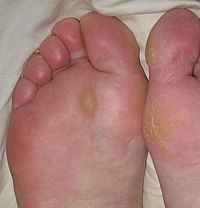
Photo from wikipedia
Abstract Non‐invasive biophysical methods were used to study the effect of antioxidant gels, which were prepared from Pinus halepensis bark extracts, vitamin C and water, on the skin of diabetic… Click to show full abstract
Abstract Non‐invasive biophysical methods were used to study the effect of antioxidant gels, which were prepared from Pinus halepensis bark extracts, vitamin C and water, on the skin of diabetic hairless mice irradiated with UV radiation of 1 and 2 minimal erythemal doses (MEDs). The calculated transepidermal water loss (TEWL) for diabetic mice was found to be fivefold higher on day 11 after irradiation, and in all cases, the TEWL values converged to their initial values on day 21. Both pinus and vitamin C gels inhibited the dehydration of the skin, while water gels did not show similar protection. At low dose of UV‐irradiation (1 MED), vitamin C gels showed the best hydration, while by doubling the UV dose, pinus gels induced significant skin‐protective effects. Upon irradiation, the mice treatment with pinus gel showed diminished inflammation in comparison with the other gels. Pinus also inhibited the hyperkeratosis of skin. As expected, 2 MEDs caused greater skin damage, such as inflammation, dryness, oxidative stress and rides (aging) compared to the damage induced by 1 MED. Graphical abstract Antioxidant‐gel protection of UV‐irradiated diabetic skin. Figure. No Caption available.
Journal Title: European Journal of Pharmaceutical Sciences
Year Published: 2019
Link to full text (if available)
Share on Social Media: Sign Up to like & get
recommendations!